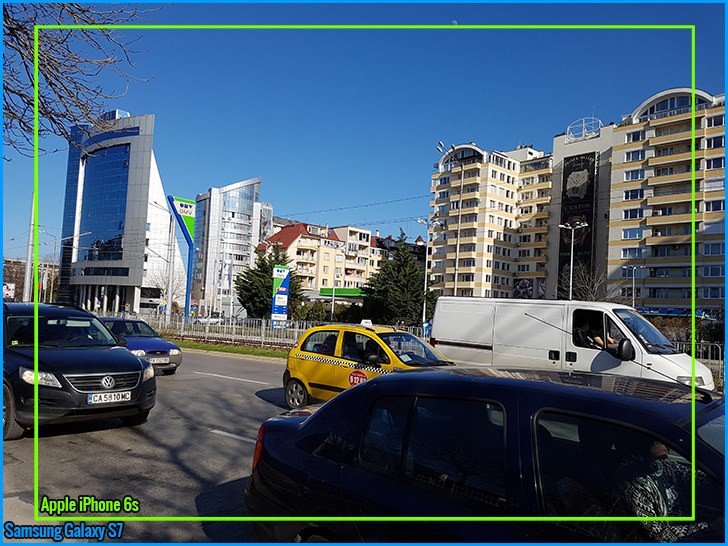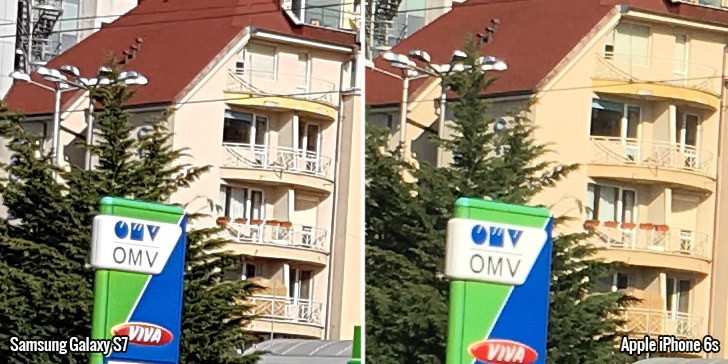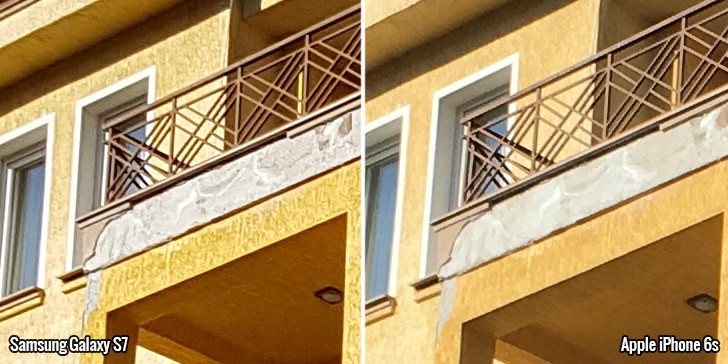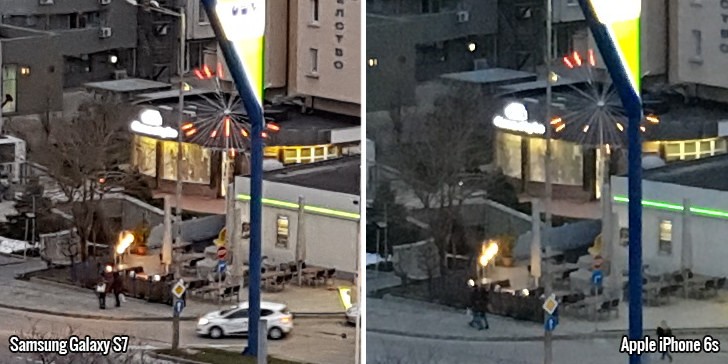Samsung Galaxy S7 vs. Apple iPhone 6s: Sixes and sevens
Sixes and sevens

Camera features
Samsung upped the ante this year by updating the most vital specs of a camera. The most important change is the Dual Pixel autofocus, which turns each and every of the sensor's 12 million pixels into a focus point.
The results are spectacular, the Galaxy S7 focuses on fast moving objects in all sorts of lighting conditions like nothing else (outside a few DSLRs). Dual Pixel is similar to phase detection autofocus in operation, but very different in scale - "phase detection" systems like the iPhone 6s has use around 5% of the sensor, Dual Pixel uses all of it.
Samsung also achieved what HTC promised but couldn't quite pull off - large pixels are great for low-light shooting. S7's pixels aren't that large - the HTC One had 2µm UltraPixels, the S7 has 1.4µm pixels and most current phones (with 16MP and above cameras) use 1.1µm.

Apple phones used to have large pixels too, the iPhone 5s had 1.5µm pixels on its 8MP sensor, but the move to 12MP with the iPhone 6 and 6s dropped the size to 1.22µ.
That's only half of the equation, though. Samsung also created the widest aperture on a mobile phone yet - f/1.7, beating LG's f/1.8 and far ahead of Apple's f/2.2.
Add in the Optical Image Stabilization - which the Galaxy S7 has but is reserved for the Plus model on the iPhone - plus S7's improved ability to focus in low-light makes the Samsung flagship a favorite for night time photography and videos.
With the iPhone 6s generation, Apple enabled 4K video recording 3,840 x 2,160px. Of course, this doesn't impress Android users who find this to be so 2013.
Anyway, Apple also introduced Live Photos - 3-second videos that start slightly before you take a photo and end slightly after (1.5s on each side). HTC was doing this with Zoe on the HTC One, so another 2013 feature.
Samsung also implemented this 3s video feature but called it Motion photo.
Both solutions have a lot more to be desired as sharing them to other users who don't have the same phone model is anything but straightforward.
Samsung has a great deal of additional features. Manual controls is perhaps the most advanced, it gives you control over manual focus, shutter speed, ISO and a few other settings. A really cool feature zooms to 100% when doing manual focus, so you clearly see whether you've got perfect focus.
Other options include live streaming to YouTube, doing Hyperlapse (Instagram's Hyperlapse still isn't available for Android) and Selective focus. You can download more modes.
Photo quality, day
Both phones have 12MP cameras and their field of view is only slightly different. The Samsung Galaxy S7 is slightly wider, but not by much (26mm vs. 29mm in 35mm equivalent). This generation Samsung went back to 4:3 sensors, after using widescreen cameras for the S6/Note5.

Note that the S7 comes with either a Sony IMX260 sensor or a Samsung ISOCELL. Those two a very, very similar with only minor differences visible in a direct head-to-head comparison.
Our test unit uses the Sony sensor.
The Samsung Galaxy S7 photos come out sharper - much sharper. It seems they are not optimized to be viewed at 100%, they appear oversharpened. At lower zoom levels the photos will appear better since shrinking photos softens them. Most of the time you don't pixel peep, but you get very close to it on a 4K UHD TV (especially if you switch to 16:9 photos).
The Apple iPhone 6s photos are softer (granted, the software uses sharpening sparingly), but there's less detail too.

Color rendering is fairly accurate (slightly exaggerated) on the Galaxy S7. The iPhone 6s colors are good too, but slightly undersaturated and leaning towards a warm yellow.





Camera samples: Galaxy S7 • Galaxy S7 • iPhone 6s • iPhone 6s
The iPhone has a slight advantage in dynamic range, the Galaxy S7 sometimes underexposes shadows that the iPhone resolves.
Both phones offer Auto HDR, so you don't have to toggle it manually. The iPhone 6s performs slightly better in terms of dynamic range, but the colors start to look off. In the Samsung Galaxy S7 HDR on shots develop jaggies (visible in the windows of the yellow building).





HDR: S7 (off) • S7 (on) • 6s (off) • 6s (on)




HDR: S7 (off) • S7 (on) • 6s (off) • 6s (on)
Apple finally upgraded the selfie camera from the lowly 1.2MP unit that iPhones had for years and the iPhone 6s comes with a 5MP shooter. The Galaxy S7 also has a 5MP selfie camera but it has a wider FoV (22mm vs. 31mm).
The Samsung camera produces sharper images and with better white balance too, the iPhone selfie cam has a very noticeable yellow tint.


Selfies: Galaxy S7 • iPhone 6s
The Galaxy S7 selfie camera has an f/1.7 aperture too, so you can expect some good late-night selfies.
Winner: Samsung Galaxy S7. This chapter could have been split into several - photos with main camera, selfies and HDR mode. The Galaxy S7 main camera captures more detail, though it goes a little overboard with the postprocessing. Still, Samsung optimized the look for viewing on consumer screens and not pro photography - for that you can use manual mode. The selfie camera was sharper too. The iPhone 6s did manage to score a small victory in this chapter - it does HDR better.
Photo quality, dusk
We waited until dusk and took a few shots. The Samsung Galaxy S7 with its bright aperture and bigger pixels shot at ISO 200, keeping noise very low. Shutter speed fell to 1/17s but the OIS was there to fend off handshake.
The iPhone 6s also shot at 1/17s and almost the same ISO too, 250. The darker areas of the image appear muddy, however, and the whole photo has a noticeable blue tint while the S7 managed to keep relatively good colors.



Dusk photos: Galaxy S7 • iPhone 6s
Winner: Samsung Galaxy S7. It was dusk when we took these photos - not even night yet - but it's about as dark as the iPhone 6s can handle and produce decent results. The Galaxy S7 came out on top in this light and its advantage only grows as it gets darker.
Reader comments
- IMAAM
- 01 Jan 2024
- xjH
No It's not waterproof
- Dokwachi
- 08 Oct 2023
- xtS
I love the Samsung s7, and iPhone 6s is good sha Just that you can't use memory card,
- naf
- 01 Apr 2023
- Bnq
no because from iPhone 7 onwards all iPhones are waterproof